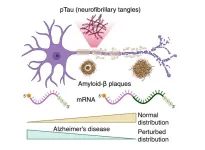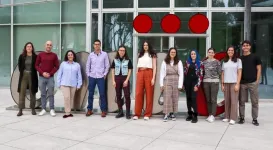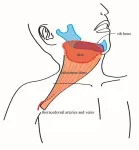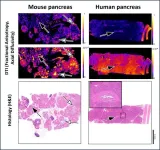More than six million Americans are affected by Alzheimer’s disease, a form of dementia marked by accumulation of amyloid-β within the brain. Amyloid-β is a relatively small protein that forms toxic plaques in the brain contributing to the harmful effects of Alzheimer's disease. Another protein, hyperphosphorylated tau (pTau), also accumulates as toxic neurofibrillary tangles. Together, amyloid-β plaques and pTau tangles result in brain damage, neuroinflammation and ultimately brain death.
Gene expression studies have already identified changes in the accumulation of RNA in the brain associated with the development of Alzheimer’s disease. However, the full spectrum of gene expression regulation associated with many neurodegenerative diseases, including Alzheimer’s, is still not well understood.
To further uncover mechanisms that regulate gene expression in Alzheimer’s disease, the National Institutes of Health-National Institute on Aging recently awarded a two-year, $310,000 grant to Petar Grozdanov, Ph.D., from the TTUHSC School of Medicine and Graduate School of Biomedical Sciences. Grozdanov, an assistant professor in the TTUHSC Department of Cell Biology and Biochemistry, will investigate how perturbed gene expression in the brain can contribute to neurodegenerative disorders like Alzheimer’s disease.
Specifically, Grozdanov’s study will focus on alternative polyadenylation as a molecular mechanism that further regulates protein expression in the brain during the development of Alzheimer’s disease. The study will seek to provide a better understanding of the complexity of Alzheimer’s disease and to advance the development of innovative therapeutics.
Grozdanov chose to investigate the changes in messenger RNA (mRNA) processing that are critical for producing important proteins from genes in the brain, specifically focusing on a process known as alternative polyadenylation.
“There are several ways to regulate gene expression,” Grozdanov noted. “The most recognized and straightforward mechanism is by changing the mRNA abundance. Basically, you’re producing more or less of a specific mRNA that is usually linked to the production of more or less protein. In fact, that is a very natural way to understand gene regulation: more of an mRNA produces more protein; less of an mRNA, less protein. Whereas alternative polyadenylation provides a fine tuning of protein production, which is underappreciated.”
Grozdanov explained that alternative polyadenylation is an RNA-processing mechanism that determines how an mRNA amino acid sequence ends by selecting specific sites called polyadenylation sites. Preferential selection of one or more polyadenylation sites within the mRNA leads to alternative polyadenylation. When the site selection occurs within the last exon of a gene (a DNA sequence found at the end of a gene), alternative polyadenylation produces mRNAs that encode the same protein. However, the length of the region between the end of the protein production and the termination of the mRNA transcript is different.
“This region of mRNA is also known as the three prime untranslated region (3′ UTR),” Grozdanov continued. “These distinct 3′ UTRs produced by alternative polyadenylation often regulate stability, translatability (how much and often an mRNA is translated to a protein) and localization of the mRNA. Alternative polyadenylation is a mechanism of regulation of gene expression that is widespread, but often overlooked since it is relatively difficult to study.”
Grozdanov also pointed out that many people may not realize how large and intricate neurons are in any given organism. In certain animals, such as giraffes and elephants, these neurons can stretch for many feet, from the head to the tail. This immense length makes it challenging for a single neuron to produce proteins at precise locations, such as in the synapses where they are most needed for brain functions like learning and memory, executive functions that are severely impaired in Alzheimer’s disease.
To overcome these physical obstacles, neurons move the mRNAs — which are crucial for protein production — to these specific sites. Alternative polyadenylation allows these mRNAs to be directed to the correct sites in neurons. And yet, no one examined alternative polyadenylation changes in Alzheimer’s patients.
“A simple way to explain it is if you have a longer transcript produced by a gene, that longer transcript is localized differently than the shorter transcript by the same gene,” Grozdanov said. “Both transcripts are producing the same protein, but their localization occurs at different sites in the neurons. When alternative polyadenylation is disrupted, basically it means that one of these polyadenylation sites is selected preferentially compared to the other one. While it is important to understand that one type of transcript does not completely disappear, alternative polyadenylation alters the balance between long and short transcripts. In Alzheimer’s disease this balance is potentially perturbed, which also can lead to interference of protein production at specific neuronal locations.”
Grozdanov said the goal of this project is to characterize the changes in alternative polyadenylation of mRNAs, or in other words, the variety of transcripts that are produced, which seem to be different in Alzheimer’s disease patients. If successful, his next goal is to investigate proteins and molecules causing these changes (i.e., finding novel molecular mechanisms contributing to the disease).
“And then, as a next question, can we modify that pathway in a certain way or reverse its influence on the diseases progression?” Grozdanov said. “In Alzheimer’s disease patients, if the length of the 3′ UTR is shorter, can we have a mechanism or a drug that adjusts their length and restores a more normal cognition for patients, and vice versa? Maybe if the patient is at a late stage of Alzheimer’s disease, unfortunately, it would be difficult to reverse the brain pathology, but it may still at least slow down the progression of this devastating disease.”
###
END






